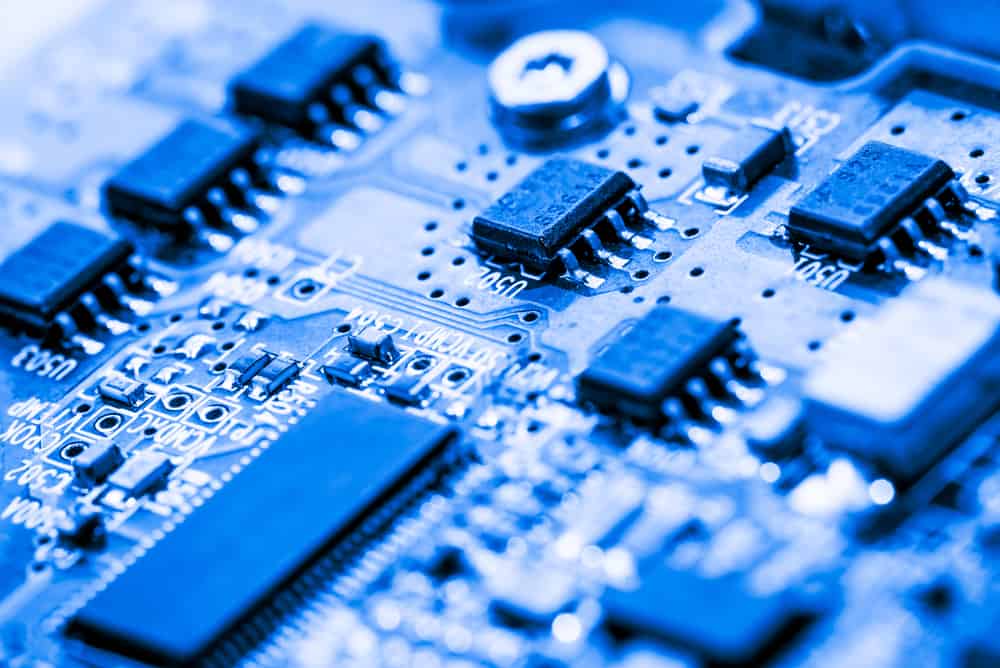
Modern electronics would not function without passive components. In terms of physical layout and the language of circuit analysis to describe electrical behavior, passive components are the simplest and yet the most critical components that can be used in a circuit board. In addition, they support the other fundamental type of components, called active components. Basic tasks performed by passive components include filtering, power delivery, level shifting, and much more.
The other fundamental component type, active components, comprises the complete opposite of simple passives: integrated circuits, transistors, and certain multi-port components. Many of these components are nonlinear, although purely linear components could also be considered active components. This article briefly explores some of the differences between active vs. passive components for newer engineering students.
What are Passive Electronic Components?
All passive electronic components have some common characteristics that define their electrical response. 1) Passive components do not generate power as an output, meaning they do not take input power and transform it to a new value; 2) passive components do not change their electrical behavior based on some input signal.
Some different types of passive components are listed below:
- Fundamental RLC components: Resistors, capacitors, and inductors are the standard passive components as these require no power source, generate no power, and do not change their electrical behavior based on some other input signal.
- Multi-port components: Multi-port components: Passive components generally have two ports (power and ground), although some passive components could have multiple ports. Packaged components do not typically exhibit this property, but it is the basis for many RF circuits that have 1 input and 2 outputs and inductively coupled components like transformers.
- Nonlinear devices: Some devices operate without a power source but have a nonlinear electrical/thermal response, such as a diode, ferrite, or an NTC/PTC thermistor. These devices are essentially passive, even though they might exhibit the same response or behavior as an active component.
- Reciprocality: Passive components could be non-reciprocal, often observed in RF components or modules. In other words, the operation of the device could depend on the direction of an input signal or power. One example of a passive non-reciprocal component is a circulator/isolator.
Aside from the two main properties listed above and these common examples, passive electronic components have a range of possible behaviors and packaging. Most passive components will appear in resistors, capacitors, and inductors in modern electronics and PCBs. Some of the most common applications of passive components are filtering, level shifting, current limiting, termination, and decoupling. In addition, many active components (integrated circuits) will include blocks of passive components precisely for this purpose.
Passive Component Packaging
All passive components will have packaging available as SMD or through-hole components, both in common packages with standard land patterns and non-standard or proprietary land patterns. Some integrated packages will simply be arrays of passive components compiled into a single package, such as the BCN164AB472J7 resistor array from TT Electronics/BI Technologies shown below.
This part is an array of 4 resistors in a single package.
Packaging is essential for the operation of passive components as it will create parasitics that modify the electrical behavior of these components. For example, in capacitors, the packaging size, materials, and mounting create some resistance and inductance, thus at some point, the capacitor stops acting like an ideal capacitor. The same ideas apply to inductors, resistors, transformers, and other passive components.
Active vs. Passive Components
All active components exhibit a common property where the output from the device can be controlled or modulated based on some input signal or power being applied to the device. For this reason, all active components are multi-port components, typically involving power, ground, and I/Os. This is exactly how integrated circuits are structured and can be modeled. Active components can also be linear or nonlinear, depending on how they respond to an input signal on an I/O and/or power.
The most common active component is the transistor, which is the building block of all modern integrated circuits. Interestingly, if not used to apply modulation, transistors can essentially be used as an active component, but in a passive circuit to provide amplification or attenuation. This is essentially what is done when a transistor is configured in DC; it will have static transfer characteristics because the operating parameters (base/gate voltage, etc.) will not change in time.
MOSFETs are one common active component.
Active components will have larger pin counts than simple passive components, ranging from hundreds of electrical connections for larger count BGAs. The packaging and footprint will also create parasitics in a PCBA, which will modify the real electrical behavior of the device. Designers building a new device with advanced packages and needing to simulate signal behavior in their designs need accurate packaging, footprint, and simulation data.
When you need to find footprints, datasheets, and application notes for your components, you can quickly find the components you need with the parts search features in Ultra Librarian. The Ultra Librarian platform gives you access to PCB footprints, technical data, and ECAD/MCAD models alongside sourcing information to help you stay ahead of supply chain volatility. All ECAD data you’ll find on Ultra Librarian is compatible with popular ECAD applications and is verified by component manufacturers to help streamline your designing process.
Working with Ultra Librarian sets up your team for success to ensure streamlined and error-free design, production, and sourcing. Register today for free.